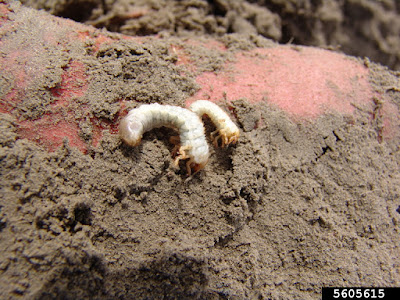Crop updates
Solanaceous crops are all being harvested, and some insect and physiological disorders are being found.
Tomato: As tomatoes are being harvested, we are seeing a wide range of physiological issues. It has been a stressful year to be a plant, and these fruit symptoms reflect that. If your tomatoes have spots, specks, cracks, scabs, dead spots, or discolored tissue, compare what you are seeing to the pictures in UMN tomato disorder webpage.
People also continue to make reports of blister beetles, so be careful when you’re harvesting.
If your tomatoes or tomatillos are splitting, this is a sign that you have likely not been irrigating frequently enough. Splitting is sometimes attributed to too much water, but more often, it is the result of uneven irrigation. If cells become drought stressed they can become more brittle, and so when there is a flush of water from a heavy rainfall or a long irrigation event, they are more likely to split open. If this is happening to you, try irrigating twice as often for half as long.
Tomatillo: A new tomatillo disease called white smut is being found in new spots around the state. This disease was first identified in 2010 in California, and not much is known about it. It causes white spots on tomatillo leaves. We don’t know how bad this disease is for the plants or their yield, or if any pesticides work to prevent it. If you’re seeing white smut, reach out! We are curious what you’re seeing and where this disease is being found in the state.
Potatoes: As potatoes and other root crops are starting to be harvested, some growers are reporting white grub feeding. This feeding looks like chunks missing from whatever root or tuber you are harvesting, if they are the damage doers, you will often surface them while digging into the soil to harvest.
White grubs are the immature form of scarab beetles (Japanese beetle, June beetle, and many others). Most of what we can do about these guys is avoiding planting root crops in spots likely to have high numbers of white grubs. Many of the most common scarab beetles (such as Japanese beetle) like to lay their eggs on grass species, so don’t grow root vegetables in areas that were fallow, turf, or pasture in their recent history.
What does recent history mean? It depends on what species of grub you have. Japanese beetles go from grub to adult in one year, while other species spend longer in the soil. To ID what species is giving you grief, you have to look at a pattern of hairs on the back end of the grubs. Cornell has a nice interactive tool that lays out this (admittedly weird but ultimately doable) process.
Peppers: We continue to see fairly high levels of sunscald in peppers. Not only are peppers with sunscald unmarketable; they serve as hosts for opportunistic pathogens. At this point in the season, it’s not too late to add shade cloth! If you’re seeing more unmarketable fruit than you’d like, consider taking some time to install 30% shade cloth. Research from multiple universities in the Northern part of the US shows that shade cloth increases marketable fruit production. Check out this recent article from University of Delaware about shade cloth trials in peppers: https://sites.udel.edu/weeklycropupdate/?p=20476
Sweet corn: We’ve received a few questions this week about how to know when your sweet corn is ready to harvest. While many growers can feel whether a cob of corn is ripe just from the firmness, this can be tricky for beginning growers. You can try pulling back the husk of a few cobs and using your thumb nail to press into a kernel. The sap should come out slightly milky. If it runs clear, fold the husk back over the cob and give it a few more days. If the kernels are covered in a web-like material, this is also a sign that your corn is not quite ripe.
Soil health grants
MDA launched a new soil health grant program this week that helps growers to purchase equipment that will improve their soil health. The grant will cover 50% of the cost of equipment (ranging from $500 - $50,000) that allows you to plant or terminate cover crops, reduce tillage, or achieve other soil health goals. Applications are due September 15th. Learn more here: https://www.mda.state.mn.us/soil-health-grant


Comments
Post a Comment